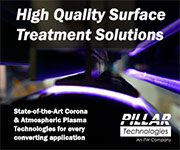High Initial Strength with Long Open Time Reactive Hot Melt Adhesive
- Published: September 01, 2001, By Ju-Ming Hung, National Starch and Chemical
PEER-REVIEWED TECHNICAL PAPERS
Following is an expanded summary of a complete paper available on the TAPPI web site at tappi.org
Email the author(s) at ju-ming.hung@nstarch.com
Application: New technology allows preparation of high initial strength reactive hot melt adhesives with long open time characteristics.
Reactive hot melt adhesives (RHMs) are solvent free, one-part solids at room temperature. These materials undergo heating to their molten state before use followed by pumping and dispensing onto construction pieces in a hot and tacky state. When the assembled substrates cool to ambient temperature, the bond strength builds rapidly due to solidification of the adhesive. The RHMs then start reacting with moisture absorbed inside the assembled pieces to form a highly crosslinked network. The cured adhesives have significantly better heat resistance than assemblies glued with conventional one-part hot melt adhesives.
In a commercial assembling process, manufacturing cost reduction through improved production rate is highly desirable. Increasing the initial strength of reactive hot melt adhesives is therefore an approach to improve the manufacture production rate. In most cases, the open times of RHMs are lower while the initial strengths of the adhesives are higher. The application for large, assembled pieces therefore has limitations. This paper describes a new technology that has allowed preparation and commercialization of a series of high initial strength RHMs with long open time characteristics.
Experimental
Ideal RHMs require several characteristics such as fast cure with good melt stability, high initial strength with long open time, excellent initial strength with low melt viscosity, good adhesion properties, superior high temperature properties, and excellent hydrolysis and solvent resistance. The technology of fast cure RHMs with good melt stability has been available. The following work shows a new technique to improve initial strength while maintaining long open time for moisture cure adhesives.
The high crystallinity temperature of the polyester diol, high glass transition temperature of the plastics, and the molecular weight of the prepolymer control the initial strengths of RHMs. Reducing the molecular weight of the isocyanate prepolymer and the glass transition temperature of the raw materials are methods to increase the open time of a hot melt adhesive. To balance these two contrary factors, the author prepared a low glass transition temperature plastic with functional groups. This unique raw material can provide a low glass transition temperature with high molecular weight in the formulated RHMs.
Several materials used different types of acrylates. The nonfunctional acrylate was replaced with a reactive acrylate at a one to one ratio with the remaining components remaining unchanged. Peel rate is the length of dislocation of the rupture bond of a vinyl strip with a hung weight from a hot glass plate at different temperatures. Bond range is measurement of the length of time an adhesive surface remained tacky after coating on a flat surface. Table I shows the important differences of each formulated sample and the uncured physical properties.
| Physical properties | Control Sample | A | B | C |
|---|---|---|---|---|
| Mn | 8,000 | 9,400 | 11,000 | 9,500 |
| OH Number | None | 10 | 5 | 10 |
| Tg, °C | 8 | 0 | 15.9 | 27.3 |
| Viscosity, cps @ 250°F | 7,200 | 8,400 | 3,600 | 38,000 |
| Peel rate, mm/min. @ 35°F | 80 | 70 | ~ 20 | 0 |
| Bond range, min. | 10 | 35 | 30 | 15 |
Samples A and B showed lower peel rate and longer bond range. The data indicated that this new raw material could provide the unique characteristics of high initial strength with long open time for new formulated reactive hot melt adhesives.
| Type of acrylate | Tg, °C | Test Result |
|---|---|---|
| Nonreactive | 80.0 | 100% adhesive failure |
| Reactive | 15.0 | 50% adhesive failure |
| Reactive | 80.0 | 0% adhesive failure |
This work also studied the different glass transition temperatures of functional acrylic copolymers. The test results indicated that RHMs containing the reactive type acrylate have better solvent and hydrolysis resistance. The data in Table 2 showed that the adhesive with the higher Tg of functional acrylic had better hydrolysis resistance. The test for the samples in the table used polyvinyl chloride strips aged for eight days in water at 275°F.
Conclusion
Reactive hot melt adhesives containing a functional acrylic can provide high initial strength with long open time. Newly formulated products showed much better hydrolysis and solvent resistance. Formulating with this new raw material can also provide a wide range of unique properties such as low viscosity with high initial strength, soft and foamable moisture cured hot melt products, and better creep resistance.













